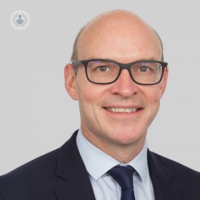Exploring new concepts in shoulder replacement
Written by:Advancements in orthopaedic surgery continue to shape the landscape of joint replacement, and the shoulder is no exception. Esteemed consultant orthopaedic surgeon Mr Andrew Sankey, who specialises in shoulder surgery, aims to provide simple and informative answers to key questions regarding new concepts in shoulder replacement.

What are the latest concepts in shoulder replacement?
Recent developments in shoulder replacement focus on improving outcomes and expanding options. These include:
Reverse total shoulder replacement
This innovative approach reverses the placement of the ball and socket in the shoulder joint. It is particularly beneficial for individuals with complex shoulder issues, such as irreparable rotator cuff tears, providing improved stability and function.
Anatomic total shoulder replacement
Anatomic shoulder replacement preserves the natural ball-and-socket anatomy. Newer designs and materials enhance durability and replicability of the joint, offering a promising option for individuals with arthritis or other degenerative conditions.
Individually manufactured PSI (Patient specific instruments)
Individually manufactured PSI guide the placement of the prosthesis intra-operatively.
Who is a candidate for reverse total shoulder replacement?
Reverse total shoulder replacement is typically recommended for individuals who:
- Have irreparable rotator cuff tears: When the rotator cuff is severely damaged and cannot support normal shoulder function.
- Experience arthritis with rotator cuff dysfunction: Combining arthritis and rotator cuff issues often makes traditional replacements less effective.
- Seek improved stability: Individuals requiring enhanced stability and function in the shoulder joint.
What conditions does anatomic total shoulder replacement address?
Anatomic total shoulder replacement is suitable for conditions including:
- Osteoarthritis: Degenerative joint disease-causing pain and restricted mobility.
- Rheumatoid arthritis: Inflammatory arthritis affecting the shoulder joint.
- Post-traumatic arthritis: Resulting from a severe injury to the shoulder.
How do these new concepts improve shoulder replacement outcomes?
Reverse total shoulder replacement
- Enhanced stability: The reversed ball-and-socket design provides greater stability, particularly in the absence of a functional rotator cuff.
- Improved range of motion: Enables a wider range of motion, enhancing overall shoulder function.
Anatomic total shoulder replacement
- Preservation of natural anatomy: Maintains the natural ball-and-socket anatomy, potentially leading to a more natural feel and function.
- Advanced materials: Utilises advanced materials for increased durability and longevity.
What is the recovery process for these new shoulder replacement concepts?
Recovery from both reverse and anatomic total shoulder replacement involves:
- Physical therapy: A structured rehabilitation program to improve strength, flexibility, and range of motion.
- Pain management: Medications and other modalities to manage postoperative pain.
- Gradual return to activities: A gradual reintroduction of daily activities and exercises to optimise shoulder function.
Are there risks associated with these advanced procedures?
As with any surgical procedure, there are inherent risks. Common risks include infection, blood clots, and anaesthesia-related complications. However, advancements in surgical techniques and postoperative care have significantly reduced the occurrence of complications.
How long do the results of new shoulder replacement concepts last?
The longevity of results varies among individuals and is influenced by factors such as age, activity level, and overall health. On average, these advanced procedures offer durable outcomes, with many patients experiencing long-term relief from shoulder pain and improved function.
Can both procedures be customised to individual needs?
Absolutely. Both reverse and anatomic total shoulder replacement procedures can be tailored to meet the specific needs of each patient. Customisation involves choosing the most suitable implant design, size, and positioning to optimise outcomes.
New concepts in shoulder replacement, particularly reverse and anatomic total shoulder replacement, represent significant advancements in orthopaedic surgery. These procedures offer improved stability, function, and longevity, providing effective solutions for individuals with various shoulder conditions. If you are considering shoulder replacement, consulting with an orthopaedic shoulder and elbow surgeon can help determine the most suitable approach based on your unique needs and conditions. Advances in shoulder replacement continue to enhance the quality of life for individuals seeking relief from shoulder pain and dysfunction.
If you require expert shoulder replacement surgery, arrange a consultation with Mr Sankey via her Top Doctors profile.


